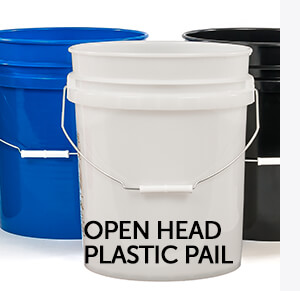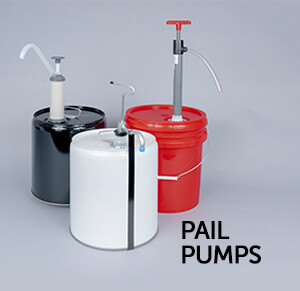

Paint Can 101 – Paint Can Uses, Materials, and Linings, Explained
Paint cans are commonly used for packaging of both industrial liquids and retail products. These containers are perfect for the storage of paints, varnishes, lacquers, and stains. Round paint cans come in sizes from half-pint to one gallon, as well as metric sizes from half-liter to five liters. Their cylindrical shape has an impressive stack strength-to-weight ratio. With so many options available to the shipper, we thought we’d help out by breaking down the features and details, so you can decide which containers are the best for your particular needs.
Plastic versus Metal Paint Cans
The obvious difference between the two containers is the material that they’re made of, but there’s more to it than that. Each type has its unique pros and cons, that make them better suited for different applications. Let’s go over the basics and the pros and cons for each can, to hopefully paint a better picture of when to use each one. Sorry for the awful pun, but we couldn’t resist!
Plastic Paint Can Basics
Plastic paint cans are injection-molded from a plastic resin, usually recycled polypropylene, usually black in color. Polypropylene is used because it offers good chemical compatibility and temperature stability. Some versions have a molded groove in the top rim of the can that’s a snap-fit with a matching lip in the lid. Other versions are a “hybrid”, with a metal ring at the top that works with a metal paint can lid.
Plastic paint cans can be provided either with or without a plastic carrying handle.


Plastic Paint Can Pros:
- Re-usability – Plastic paint can lids can be snapped on and off hundreds of times, without damage and without affecting the seal. This helps keep the contents fresher, longer, even with repeated opening and closing. Plastic is easier to clean out and reuse.
- Durability – Plastic cans are much more resistant to denting and damage in filling, transport, storage and use. And, of course, they will never, ever rust.
- Weight – Size for size, plastic cans are generally lighter than metal ones, which can save you money when you’re calculating your freight cost.
Plastic Paint Can Cons:
- Product Compatibility – Plastic paint cans most often used for water-based liquids, like latex paint. They shouldn’t be used for solvent- or oil-based liquids.
- Environmental susceptibility – Plastic paint cans need to be stored in a temperature-controlled location. Extremes of temperature may cause warping or cracking.
- Recyclability – Although many plastic paint cans are themselves made from recycled resins, there are limited ways to recycle the cans after they’ve been emptied.
Metal Paint Can Basics
Metal paint cans were invented in the early 19th century to replace the glass and ceramic containers previously in use. They were a lot better, for obvious reasons! Often referred to as “tin” cans, they are actually made from tin-coated steel (“tinplate”). The cylindrical body is rolled and welded from flat stock, and the tinplate bottom is double seamed. A tinplate ring that accepts the lid is seamed into the top of the can. Tinplate is attractively shiny and rust-resistant. The exterior can be painted or highly decorated, and the inside can be coated with different linings to be compatible with a wide range of products. More about that later.


Metal Paint Can Pros:
- 100% Barrier – Metal cans are completely impervious to air and light from outside, and positively prevents product migration.
- Temperature tolerance – Metal retains its strength under extreme temperatures; plastic can crack, distort, or melt.
- Recyclability – Steel is highly recyclable and by far the most recycled metal on Earth. Over 40% of new US-made steel comes from recycled metal.
Metal Paint Can Cons:
- Rust – The exterior of a metal paint can is rust resistant, and the interior can be coated with lining that impedes corrosion, but over a long period of time, rust is likely to form.
- Damage – Metal cans are susceptible to dents and dings during transportation and handling.
- Re-sealability – The seal between the can and lid depends on a tight friction-fit between the can and lid. Product on these surfaces can be difficult to clean and can affect the seal.
Ultimately, to choose the right paint can material for you, you need to consider your application, priorities, storage capabilities, and the material that you’re containing. And, you can always reach out to us at BASCO for expert help
What are paint can linings? Which lining is right for me?
Some think that lined paint cans are supposed to prevent the interior from rusting, like the paint on a car prevents the fender from rusting. The real purpose of a can lining is to protect the product from reacting with the metal can. Plastic cans are, by their nature, rust and corrosion-proof. They have no need for lining.
Metal can linings are sprayed into the can after forming, then cured in an oven.
Epoxy – A pigmented coating designed for products with a higher (alkaline) pH.
Phenolic – Have a high level of resistance to solvents and low pH (acidic) products, such as foods, inks, essential oils, and other hydrocarbon products.
Epoxy-Phenolic – Outstanding chemical resistance to higher pH (alkaline) products, like foods, surfactants, detergents, water-based resins. Epoxy gives extra flexibility to the lining, minimizing the risk of cracking.
Organosol – A gray pigmented vinyl dispersion, commonly used for aggressive water-based products. It is applied in a much thicker film than epoxy linings.
If there is no problem with a product interacting with the metal, cans can be provided with a rust inhibitor that will impede flash rust and allow more time in storage before filling.
Tips on paint can storage for paint users
The ideal storage method depends on the product inside the cans, but there are some general rules of thumb that will help prevent the degradation of your containers as well as the products inside.
Store indoors:
A temperature-controlled indoor space is best for keeping your paint cans safe from the elements, both before and after filling. Exposure to things like rain, extreme temperatures, high humidity, or direct sunlight can cause metal containers to rust or plastic containers to warp and crack. Those conditions won’t do any good to the contents, either!
Use labels:
Repeatedly opening and reclosing your paint cans risks damage to the can and product degradation, too. If your cans are properly labeled you can immediately tell what’s stored inside, and use older materials first.
Try labeling your paint cans with more than just the color. Some categories that you might consider are color, type, locations used, date first used, and brand.
Use smaller containers for leftovers:


Storing a pint of paint inside a gallon can wastes space and exposes the remaining paint to a lot of air. Instead, use smaller sized cans, like quart or pint sized, to contain your leftovers. Or, store small amounts of paint in glass jars with convenient screw caps that are easier to open, close, and keep clean. Check out Jar Store for some solid storage jar options.
Where can I buy paint cans?
And now, a word from our sponsor! BASCO offers a wide variety of paint cans – you can get every container described in this article, and hundreds more, right here. In fact, you can find every kind of metal, plastic, fiber, or glass container from ¼ ounce all the way up to 330 gallons, at BASCO.
BASCO is dedicated to providing our customers with the answers they need to get the job done right. With our decades of experience in the container biz, it’s our mission to share our knowledge with people who need it. Hopefully, this article was useful, and if you have any questions that we haven’t answered, please feel free to reach out and contact our expert customer service team!






